
Concept explainers
(a)
Evaluate
(a)
Answer to Problem 54RE
At x = 1:
Explanation of Solution
Given information:
The graph of a function f :
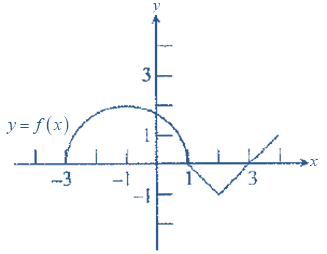
Calculation:
We have
At
By evaluating the integral:
Therefore,
(b)
Evaluate
(b)
Answer to Problem 54RE
At
Explanation of Solution
Given information:
The graph of a function f :
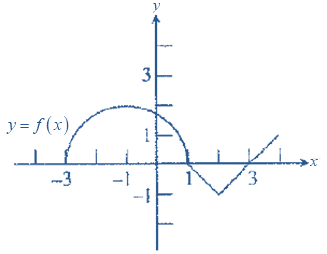
Calculation:
Since
Then
The area of the graph between 1 and 3 is a triangle below the x − axis.
Thus,
It has a negative area.
That includes
Base of 2 and Height of 1.
Then
The area:
(c)
Evaluate
(c)
Answer to Problem 54RE
At
Explanation of Solution
Given information:
The graph of a function f :
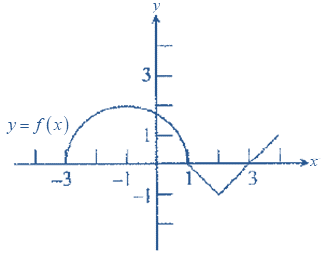
Calculation:
We have
Substitute
To switch the bounds, use the Order of Integration rule:
The region from
Then
Use the formula for the area of the quarter circle:
Therefore,
(d)
All values of x on the open interval [-3, 4] at which g has a
(d)
Answer to Problem 54RE
Explanation of Solution
Given information:
The graph of a function f :

Calculation:
To know where
Since
According to FTC:
Then
And
Therefore,
(e)
Equation for the line tangent to the graph of g at
(e)
Answer to Problem 54RE
Linear function:
Explanation of Solution
Given information:
The graph of a function f :
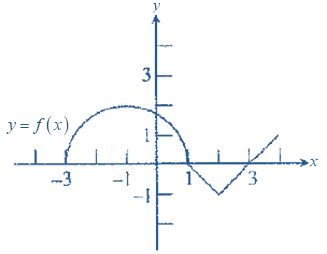
Calculation:
The slope of linear function:
From Part (c) result,
We have
Then
The Linear function:
Rewrite the above equation:
Therefore,
(f)
x − coordinate of each point of inflection of the graph of g at
(f)
Answer to Problem 54RE
x − coordinates of the points of inflection:
Explanation of Solution
Given information:
The graph of a function f :
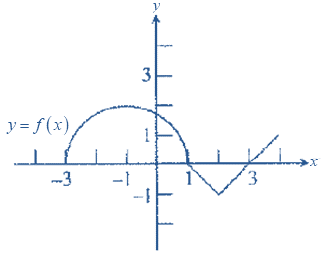
Calculation:
The points of inflection of g occur at x − values.
Such that
Since
Then
That further becomes
Therefore,
The values of x that make
From the graph of f ,
The slope of f is 0 at
Thus,
And
The slope of f is undefined at
Thus,
f’ switches from positive to negative at
Then
f’ is negative to the left and right of
Then
f’ switches from negative to positive at
Therefore,
The x − coordinates of the points of inflection are
(g)
Range of g
(g)
Answer to Problem 54RE
The range is [
Explanation of Solution
Given information:
The graph of a function f :

Calculation:
In order to obtain the range of g ,
We are required to find the absolute minimum absolute maximum of g .
To obtain absolute extremes,
We are required to find the critical values and evaluate those critical values and endpoints in the original function to know which gives the largest value and which gives the least.
Since
Then
From the graph,
At
And
At the endpoints:
At
At
At
At
Therefore,
Absolute minimum is
And
Absolute maximum is 0.
Then
The range is [
Chapter 6 Solutions
Calculus 2012 Student Edition (by Finney/Demana/Waits/Kennedy)
Additional Math Textbook Solutions
Precalculus
Thomas' Calculus: Early Transcendentals (14th Edition)
Precalculus Enhanced with Graphing Utilities (7th Edition)
University Calculus: Early Transcendentals (3rd Edition)
Precalculus (10th Edition)
Calculus: Early Transcendentals (2nd Edition)
 Calculus: Early TranscendentalsCalculusISBN:9781285741550Author:James StewartPublisher:Cengage Learning
Calculus: Early TranscendentalsCalculusISBN:9781285741550Author:James StewartPublisher:Cengage Learning Thomas' Calculus (14th Edition)CalculusISBN:9780134438986Author:Joel R. Hass, Christopher E. Heil, Maurice D. WeirPublisher:PEARSON
Thomas' Calculus (14th Edition)CalculusISBN:9780134438986Author:Joel R. Hass, Christopher E. Heil, Maurice D. WeirPublisher:PEARSON Calculus: Early Transcendentals (3rd Edition)CalculusISBN:9780134763644Author:William L. Briggs, Lyle Cochran, Bernard Gillett, Eric SchulzPublisher:PEARSON
Calculus: Early Transcendentals (3rd Edition)CalculusISBN:9780134763644Author:William L. Briggs, Lyle Cochran, Bernard Gillett, Eric SchulzPublisher:PEARSON Calculus: Early TranscendentalsCalculusISBN:9781319050740Author:Jon Rogawski, Colin Adams, Robert FranzosaPublisher:W. H. Freeman
Calculus: Early TranscendentalsCalculusISBN:9781319050740Author:Jon Rogawski, Colin Adams, Robert FranzosaPublisher:W. H. Freeman
 Calculus: Early Transcendental FunctionsCalculusISBN:9781337552516Author:Ron Larson, Bruce H. EdwardsPublisher:Cengage Learning
Calculus: Early Transcendental FunctionsCalculusISBN:9781337552516Author:Ron Larson, Bruce H. EdwardsPublisher:Cengage Learning





